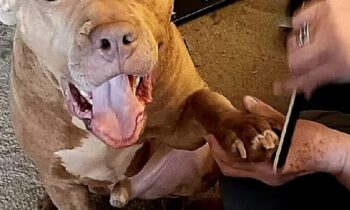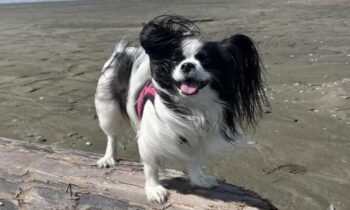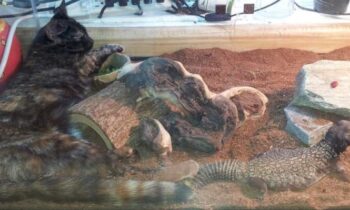![]()
When our veterinarian said that my dog must wear an Elizabethan collar, what was my first mistake?
I didn’t know the collar I borrowed after his surgery was not the right size for him!
I was supposed to be using the Elizabethan collar to keep my dog from interfering with the bandaging on a back paw while it healed from the procedure, which usually takes ten days to two weeks. I spent the first days of that time afraid to step away from my dog for more than a few seconds.
My veterinarian realized that I needed a much bigger “cone of shame” to keep my dog out of trouble.
Use a Cone That Fits the Size of Your Dog and the Reason for Its Use
In my dog’s case, the cone we borrowed was his “size”—he and the dogs who’d worn it before him are not dissimilar in height and weight. He is the size and shape of a larger Australian shepherd or a golden retriever, and the dogs he borrowed the cone from are good-sized boxers.
Have you guessed where the striking dissimilarity occurred? Length of muzzle, basically! Think of a boxer’s flattish face, then think how the nose sticks out from the face on an Aussie or a golden. My dog’s muzzle is much longer.
Hence the problem. If my dog’s mouth could reach his healing back paw, he could end up interfering with it. In the cone we first borrowed, his mouth was very close to the outside edge of the cone—way too close to that tempting bandage.
In the bigger cone, his mouth is almost a foot away from the edge. He may be “bendy,” as our vet says, but he’s not a contortionist. His mouth simply can’t reach that bandage.
He certainly still needs to be supervised, but he doesn’t have to be watched—I don’t have to be with him—every single minute. It’s a whole new world.
How do you know what size (or style) of “cone” will best suit your dog and your dog’s needs? Ask your veterinarian!
Do you have a cone that you’ve borrowed or have stored away? Take it with you—before your dog’s need for it, if possible—to your veterinary clinic and ask!
Once you have a specific cone size in mind, you can order online or buy locally. You may even find that your veterinary clinic stocks the size you need, so you can buy one right there.
Locally, online, or at your vet’s office, look for a policy that allows returns for store credit or exchanges if the equipment does not fit or suit the dog’s needs.
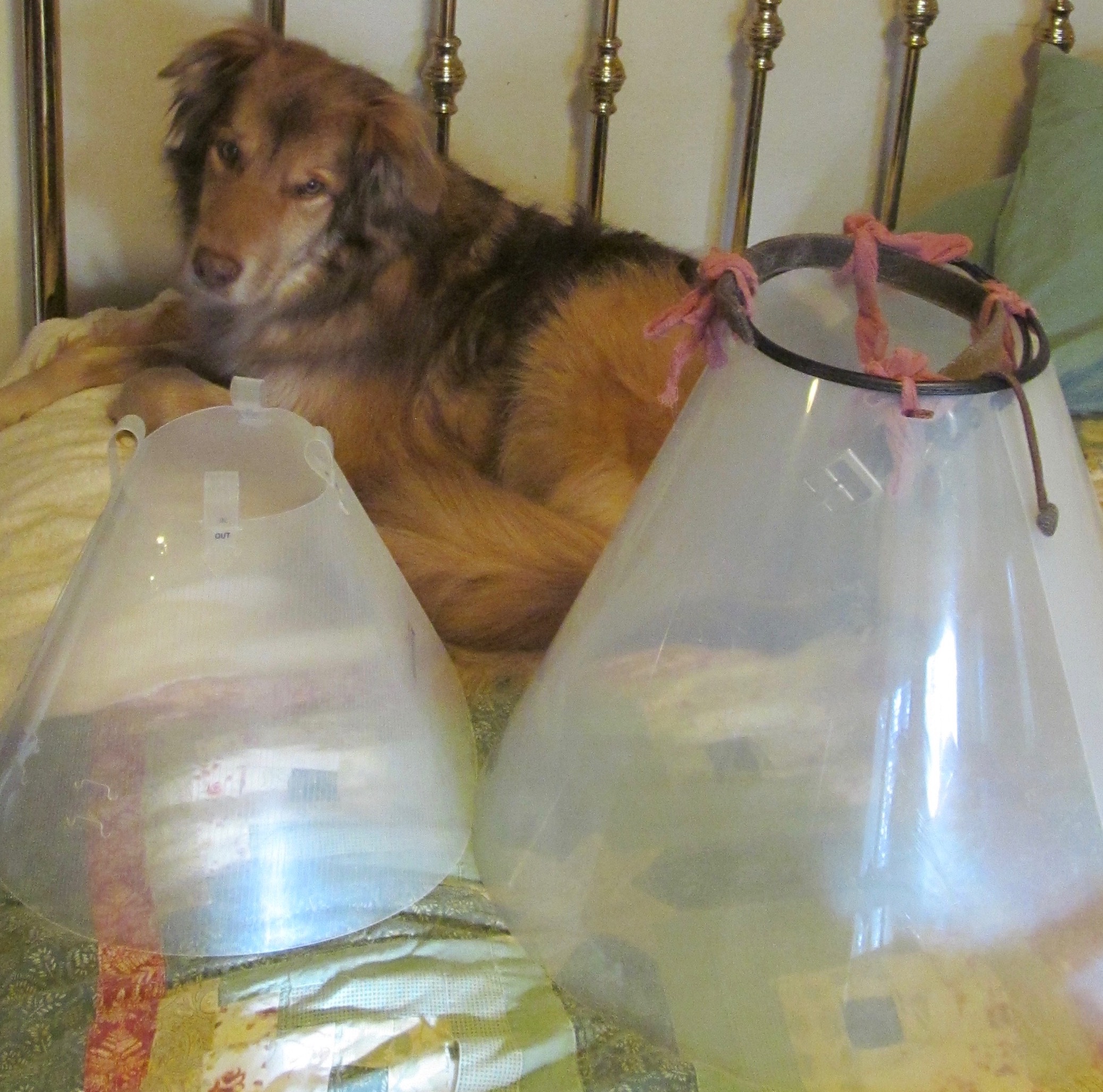

Photo by Val Hughes
Keep Your Dog in a Safe Place While She Has to Wear A Cone
Ideally, if your dog is wearing a cone of an appropriate size for her veterinary need and you have a crate big enough for her, in the cone, to turn around and to lie down, then a crate could be as safe a place as any to leave her when you can’t be there to supervise. Crating her in the car, in her cone—if she’s used to being in a crate in your car anyway—sounds like less stressful travel for her . . . and you, too!
When my dog initially went nuts in the borrowed cone, I decided that his wearing that cone in a crate would be out of the question. He could wedge himself into the kennel, but then he was stuck, standing backward, his rear end in the entrance.
It wasn’t that he couldn’t turn around—he was unwilling to. By that time, he’d had more than enough of bashing the cone into walls. He did not find it rewarding, and he chose for himself to stop doing it.
I produced a cookie and he exited the crate.
When your dog was a puppy, learning to be housebroken, or new to your family, you may have used an exercise pen to confine her inside. For a dog in a cone, though, a free-standing exercise pen might not be safe. If the cone disorients the dog and she bashes herself against the pen, there’s a chance the pen could collapse (maybe even on the dog).
Set up the ex-pen safely, so there’s no way it can move or topple. It could be a good management option for your dog, as long as you are close by and check in often.
Is it practical to keep the dog with you while she’s wearing a cone? That depends on what the dog’s recovering from. If your veterinarian okays all normal activity for her, give it a try at home for a short period of time to decide if it’s practical.
Experiment with the umbilical-cord method. If the dog’s physical condition allows it, harness the dog. Attach one end of a leash to the harness, the other end of the leash to your waist. Use a six-foot leash or improvise with a light rope (cotton clothesline cord is human-friendly) that’s a few feet longer. You will be hands-free to go about your normal household tasks, with the dog attached to you. Use lots of praise and treats!
Unfortunately, it’s impossible for me to walk around my home with my dog in his giant cone umbilical-corded to my waist. He can’t maneuver through a doorway wearing that cone. Together, only a few feet apart, we would be a walking disaster and he might get hurt.
But in a different setting, with a different size of dog or size of cone, it might be an excellent “enrichment” activity for a dog who otherwise would be stuck in one place most of the day because of wearing a cone.
What About the Activities Your Dog Can’t Do in a Cone?
Your dog cannot eat meals or drink water while she’s wearing the cone? You’ll have to figure out how to manage her eating and drinking without chancing an escape or attempt to “get at” the part of her body she can’t be allowed to interfere with.
It’s a situation you can train for ahead of time, if you know you’ll need to “cone” her in the future. For example, dogs don’t generally eat their meals while on a leash, and you could get your dog used to that.
Dogs often drink water while on leash, so how about putting that behavior “on cue” for your dog? Drinking water can be important to your dog’s recovery. Remember to give her frequent cone-free time to comfortably hydrate. Consider adding some or more (warm) water to her regular meals.
My dog likes to lick his front legs and paws after eating. He cleans up his privates after he’s been outside to eliminate. It doesn’t take him long, a lick and a promise, so a few minutes with the cone/s off for self-care seems like a good investment of my time, watching him carefully while he works.
Don’t risk the dog’s interference with the body area you’re trying to protect. Stay close. Keep her confined.
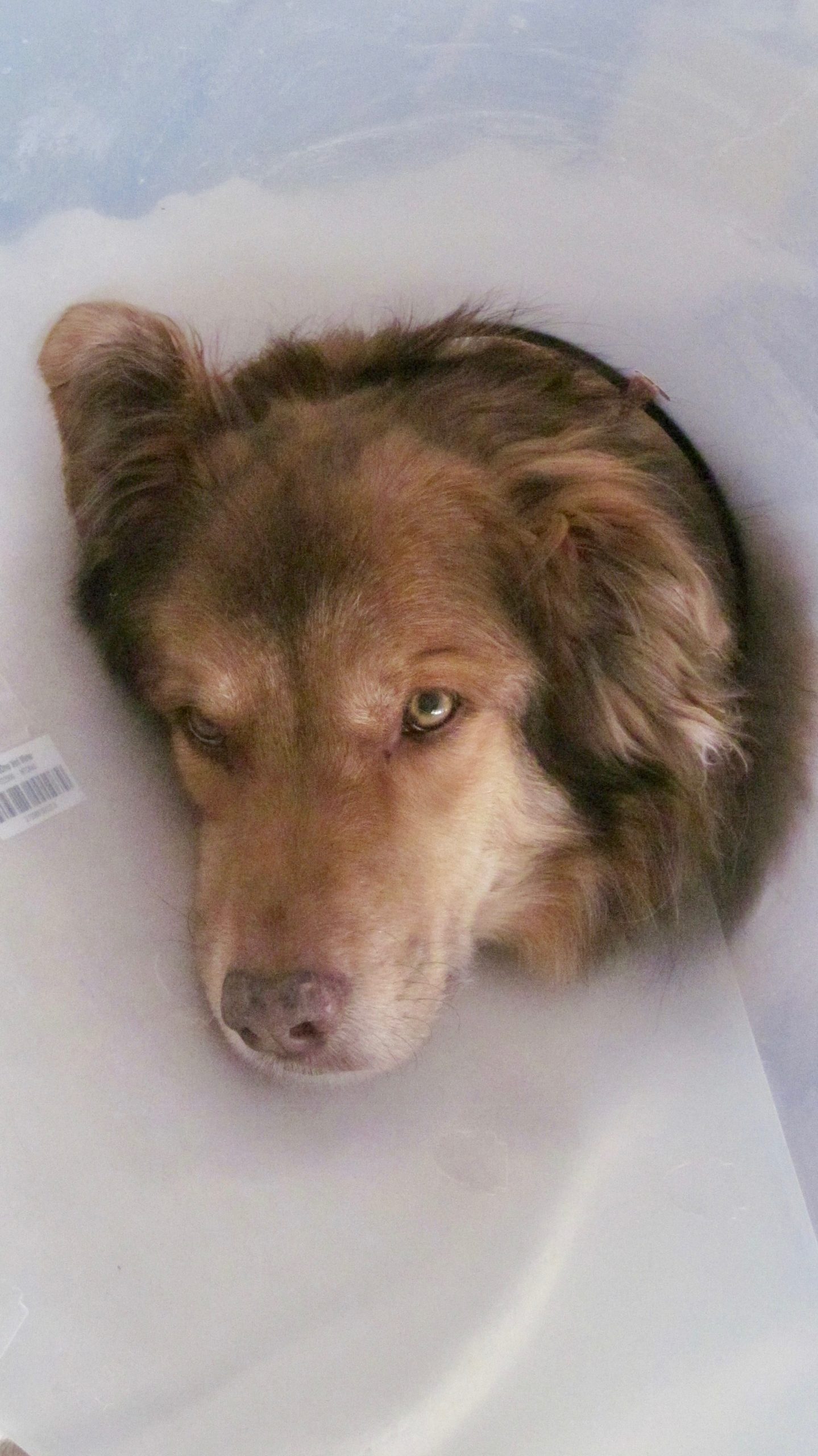

Photo by Val Hughes
How About Treats for Dogs Wearing a Cone?
Offering treats to dogs in cones should follow certain rules.
▪ The treat must be delivered from your hand, not thrown. (Your dog in a cone is not the ring toss game at the state fair.)
▪ The dog must take the treat gently, no teeth. Use the “feeding a horse a cube of sugar” method—treat in your open palm, right under the dog’s nose. (You can catch the crumbs and re-feed them to the dog.)
▪ Avoid a treat so big your dog will have to break it into pieces if she can’t hold it all in her mouth. It will be too frustrating to your dog to let treat pieces fall out of the cone and onto the ground if she can’t reach the pieces with her mouth because she’s wearing a cone!
Treats for dogs in cones?
▪ String cheese pieces—long, skinny strips frozen until it’s time to use them (thanks for this great idea to Greta Kaplan, Fuzzy Logic Dog Training, in Portland, Oregon)
▪ Pieces of the dog’s kibble
▪ Softened pieces of the dog’s kibble (put small amount of kibble in small baggie, add several tablespoons of water, seal, and shake occasionally; use when soft)
▪ Dried liver in very small pieces
▪ Tube meat (processed meat chopped into small pieces)
▪ Soft food in a squeeze tube
Soft foods like peanut butter, yogurt, and squeeze cheese might sound like a good idea when you’re looking for a treat that won’t leave crumbs, but reconsider. Think about how your dog might react if a smear of peanut butter, yogurt, or cheese got left on the plastic part of the cone only inches from her face . . . but she can’t reach it!
I’d be afraid that any visible smear (or invisible scent) of a dog’s highly valued treat on the cone she’s wearing might prove irresistible. Dog only knows what might happen next, but I’m guessing it wouldn’t end well.
Try using a squeeze tube instead, but experiment first with what you put in and how it squeezes out. Your goal is to have the dog ingest all of the substance that comes out of the squeeze tube, without dribbles or drips you have to clean up.
When the dog is wearing a cone, normal go-to suggestions for alleviating boredom with treats are simply not going to work. KONGs, feeder toys, food puzzles, and snuffle mats are out, disqualified because they would be practically inaccessible for a dog whose mouth can’t reach the surface on which she’s standing (or lying on, in most cases). Chew toys like Nylabones and bully sticks might also be inaccessible once they’ve been dropped the first time.
You might devise, if you are very clever, some sort of a “holder” for a bully stick, so the dog could reach it while the cone is on. If you’re successful with your invention, let me know what you come up with. I’d like to try it, too!
Can I Keep My Dog from Going Crazy While She’s Wearing a Cone?
In general, my dog has been cooperative with wearing his cone. He clearly had a learning curve, from bashing around like a fool when he wore a cone for the first time—my fault, not his—to figuring how to maneuver the new bigger cone around without knocking the cat off the bed. I have one bruise, on my forehead, from where he hit me with that darn thing! I hold my hand up to guard my face now when he moves around. He’s also figured out how to sleep somewhat comfortably with that contraption on his head. He is cone-free when he’s off the bed, to go outside or downstairs.
He’s lived here for a long time; he’s not a newbie in our family. We understand each other fairly well. He knows the basics, he knows the drill, he knows the household rules. He follows most of those rules regularly. He’s not a sneaky dog; he’s very honest. He’s not a youngster with a need for lots of exercise or constant mental stimulation. He’s okay with sleepy days. I think all of that has helped. With a younger dog, a newer dog, a dog used to much more excitement, it could have been different.
Next week, suggestions and stories from dog lovers and dog professionals who’ve experienced the ups and downs of having their own dogs in cones. It can be necessary, but it isn’t always easy!

